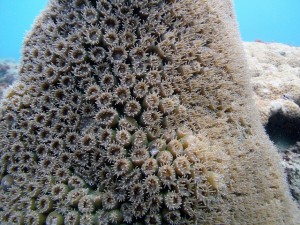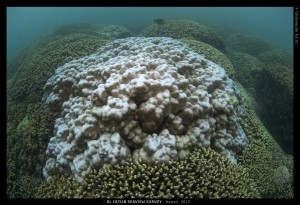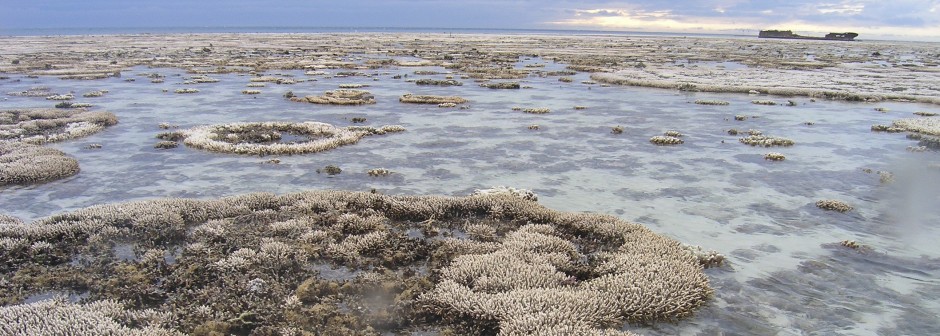We have all dreamed of visiting the idyllic waters of Hawaii, with colorful fish flitting around corals that reach up from the ocean floor towards light filtering in from above. Perhaps a moray eel sticks his head out from one of the many crevices in the reef to say hello – or is he warning you away? A few meters away, a green sea turtle dives down to graze on sea grass waving gently with the current.
But this perfect scene might remain a dream, if scientists’ predictions are correct. Current ocean conditions are putting corals at risk of coral bleaching, a phenomenon where corals lose their color. Some reefs in Hawaii have already begun to bleach, while others will likely bleach in the near future. So what is coral bleaching, and why is it happening?
Although they look like rocks, corals are animals. Each coral is made up of tiny polyps that deposit calcium carbonate underneath them as they grow. This means that only the outside layer of the coral is alive, the rest has become stone. Corals get their coloration from tiny single-celled algae called zooxanthellae. The zooxathellae are in a symbiotic relationship with the coral, meaning both the algae and the coral benefit from the relationship. The zooxanthellae are photosynthetic and create carbohydrates and other nutrients for the coral, while the coral provides protection and nutrients that the algae needs in order to photosynthesize1.

Coral polyps evident on a coral in Florida. Image Credit: Brett Levin
Coral bleaching occurs when the symbiosis between coral and zooxanthellae breaks down. This usually occurs in high-stress environments, such as when the water temperature remains too high for long periods of time, or when sunlight reaching the corals is too direct and bright. During coral bleaching, the zooxanthellae leave the coral tissue, which makes the coral appear pale or white. It is unclear whether the coral kick out the zooxanthellae or whether they leave on their own2. Coral bleaching is a problem because most corals cannot obtain enough nutrients without the help of the symbiotic algae. So although corals can survive a bleaching event if they get their algae back, they have a limited time frame in which to do so.
The National Oceanic and Atmospheric Administration (NOAA) recently released a report warning that we are entering the third global bleaching event ever recorded3. Each bleaching event has been correlated with El Niño, a climate pattern that raises ocean temperatures in the Pacific Ocean. The first two events happened in 1998 and 2010. Although some reefs had mortality rates as high as 80-90% during the 1998 event, Hawaiian reefs were left largely unscathed4. This was not the case during the 2010 event. In Kaneohe Bay, which makes up 15% of all coral in the United States, 75% of coral species bleached to some extent, and 12% died5. The most recent bleaching event is predicted to cause even more damage.

Bleached coral in Kaneohe Bay (2015). Image Credit: XL Catlin Seaview Survey
Coral ecosystems are extremely important. Corals provide a 3-dimensional structure that is home to huge numbers of fish and other marine species. Bleaching has the potential to ruin these ecosystems, putting thousands of organisms in danger. Scientists are worried about coral bleaching because it could cause chain reactions and lead to effects that we wouldn’t usually consider, like coastal erosion. Reefs protect coasts by reducing wave energy. If the reefs die and disintegrate, coastal areas will be hit with more wave energy and could be drastically altered.
From what we have observed, bleaching events seem to be correlated with El Niño, because temperatures are raised for long periods of time. But water temperatures recorded during each global bleaching event have continued to rise, and bleaching events have become more common. This is where climate change comes in, and where we may be able to alter our behaviors to help the corals. By stopping or slowing down climate change, we may be able to give corals a chance to adapt to higher water temperatures. We can also help corals by deterring their competitors, macroalgae6. When corals bleach, they are unable to compete with other algae (not the symbiotic zooxanthellae). The algae overgrow the coral and prevent the coral from recolonizing the area. Because algae like water with a lot of nutrients and algae prefer water with few nutrients, we can help corals by refraining from polluting the water with nutrients, such as fertilizers. In this way, each of us may be able to contribute to maintaining the picturesque tropical scenes that we love so much.
1 “Symbiotic Algae.” Coral Reef Conservation Program. NOAA, 2011.
2 Rowan, Rob. “Review-Diversity And Ecology Of Zooxanthellae On Coral Reefs.” Journal of Phycology 34.3 (1998): 407-17.
3 “NOAA Declares Third Ever Global Coral Bleaching Event.” NOAA, 8 Oct. 2015.
4 Goreau, Tom, Tim McClanahan, Ray Hayes, and Al Strong. “Conservation of Coral Reefs after the 1998 Global Bleaching Event.” Conservation Biology 14.1 (2000): 5-15.
5 Tribune Wire Reports. “Most of Hawaii’s Coral Recover from Mass Bleaching: DNR Survey.” Chicago Tribune, 29 Jan. 2015.
6 Associated Press. “Hawaii to Experience Worst-ever Coral Bleaching Due to High Ocean Temperatures.” The Guardian. Guardian News and Media, 13 Sept. 2015.

